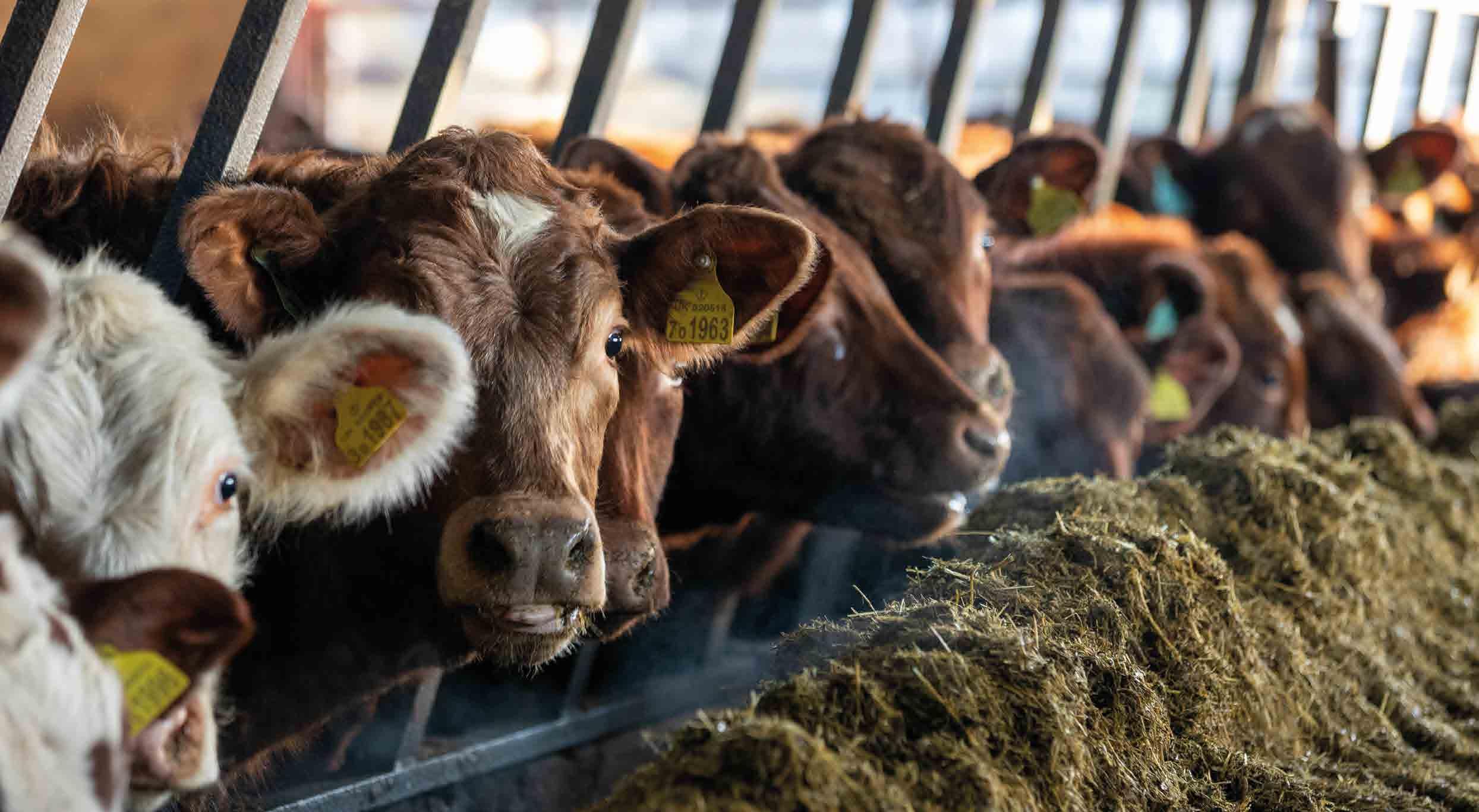
10 minute read
Lowering costs with Shorthorns

Beef Shorthorns reduce costs at Rattray
Advertisement
“I firmly believe Beef Shorthorn is the way forward towards the Home Farm maintaining a profitable enterprise that’s sustainable and heading to net zero.” Calum Clark
For Calum Clark, Farm Manager at Rattray Home Farm, Beef Shorthorn is the one breed that ticks all the boxes. Rattray Estate is owned by the Comyn family and today the Home Farm is focused on producing high quality healthy food from a low input organic system which is both environmentally and financially sustainable.
Arriving at Rattray Home Farm in 2016 Calum quickly saw the potential Beef Shorthorn genetics could bring. “We inherited a herd of 70 Continental cross cows that were in continuous flight mode. However, we brought with us 16 Beef Shorthorn cross suckler cows and a stock bull, and the rest is history. We heavily culled the Continental crosses and started to rebuild with Beef Shorthorn.”
“Beef Shorthorn genetics have enabled us to strip to the bone both the herd’s fixed and variable costs and since organic conversion, still achieve commendable performance,” he explained. “For example, last year the entire pedigree herd calved within eight weeks and recorded 96% calves reared, and the Beef Shorthorn cross herd achieved 97% calves reared. The breed is proving to be a healthy sustainable suckler delivering in a very low input organic system.” An Early Encounter
Calum’s first introduction to Beef Shorthorn was over 35 years ago at Turriff Show. “When it came to the final ring parade, us kids got the opportunity to walk ahead carrying the breed placards. Uppermill Beef Shorthorn won the show championship that year, and stockman Robbie Minto happened to hand me the placard to lead the parade. That bull was such a gentle giant and I immediately fell in love with the breed.”
After leaving school he gained varied on farm experience from tractor driver to stockman before an opportunity at Rattray Home Farm saw him achieve his lifetime’s ambition to become farm manager. The Beef Shorthorn breed has been instrumental in enabling him to make some big improvements to the farm.
Improving the Herd
“We made our first foray in to purchasing purebred females to establish the herd back in 2016 with a handful of in-calf heifers from Cairnsmore, Galla and Shawhill. They’ve proved to be great breeding cows and we still have them in the herd. We’ve introduced more genetics from Chapelton, Hurtiso and the Hildaland dispersal to reach the stage where we’re about to close the herd.
“We are expecting our pedigree cows to last for up to 13 calf crops, while some of our commercial cows have already done 10 and are still looking fresh. Our homebred bulls are now working in both our own and one other commercial herd, and we’ve sold a few at Stirling bull sales.”
Calum added, “Virtually all our Beef Shorthorn crosses carry Salers genetics, and we’ve found the combination makes for a great suckler - she’s got milk which makes for good calf growth and calving outdoors in April on to a rising plain of nutrition makes for perfect timing.”
Organic Conversion
Rattray began organic conversion in 2019 and gained Scottish Organic Producers Association accreditation two years later. “With uncertainty about future support payments, organic seemed the way forward,” Calum explained. “There was growing demand for organic product, it was positive for the environment, took us in the right direction towards net zero, and overall it just made for good business sense.”
The business benefits of this change of approach continue to accumulate. Calum added, “We are making huge savings in this system. For example, we no longer buy fertiliser and feed very little creep. We are currently rejuvenating very old permanent pasture, direct drilling with a mix of both short-term organic dual mixes including deep rooting clover and longer-term perennial species.”
The docility of the Beef Shorthorn breed is another big bonus in converting to a low input approach.
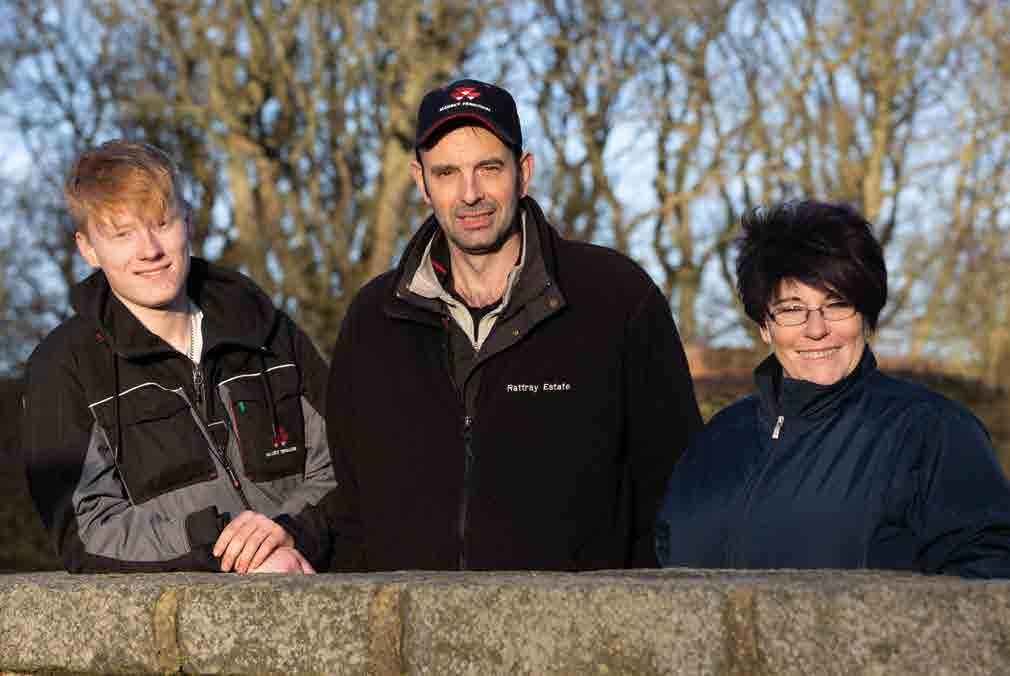
“Our Beef Shorthorns are docile, so they’re very easy to handle which is really important with just my wife, Ann, and myself managing the livestock.
With farm labour becoming increasingly scarce, farming cattle with an easy, quiet temperament is a priority,” Calum added.

Calum Clark (c), manages the Rattray herd with help from his wife, Ann, and son, Shaun.
Market Opportunities
Marketplace premiums have more than made up for any slight fall in output during the farm’s conversion to organic. All youngstock, apart from heifers retained as replacements, are traded the following spring, and Calum achieved a 15% to 20% premium for 11-month-old steers sold through the ring.
New added-value markets are also emerging for the organically reared stock. “We’re optimistic our pure and cross bred heifers will be sought after this season by suckler producers looking for a modern sustainable suckler. Demand for

Docility is an increasing important trait and one the Shorthorns are bringing to bear at Rattray. Beef Shorthorn is soaring, and bulls are already in demand from Angus and Continental suckler herds introducing a cross breeding strategy.”

A Low Input Future
The breeding females thrive on forage diets - rotational grazing, silage and winter stubbles, supplemented with mineral licks – with their grazing action helping to create a biodiversity boost, particularly important for the wildlife at nearby Loch of Strathbeg RSPB reserve.
“They’re great foragers both on the permanent pasture and in sand dunes. They’re able to use poor-quality natural vegetation and they’ve made a huge impact tidying up the old Bent grasses and encouraging fresh growth. This is helping to create a great wildlife habitat for thousands of nesting wading birds.”
The herd outwinters on the estate’s sand dunes from late November until 10 days prior to calving in April when they’re returned to paddocks near the steading.
“We calve everything outdoors and calving itself has never been an issue, not even in the snow. Last season, we handled just eight out of 100 cows, including a breach and twins.”
Winter accommodation is reserved solely for the weaned calves requiring minimal purchased inputs, a small amount of purchased straw, mineral licks and organic oat pellets – a byproduct of Rattray’s home grown oats processed for human consumption.
Looking to the future Calum added,
“Going forward we fully intend to continue a simple low input system in which we’ve proven that our Beef Shorthorn genetics can deliver.
High herd health is the ultimate goal. Our cattle are performing, they’re in demand and are able to command a premium. That strategy is going to be the key to Rattray remaining resilient and sustainable.”
Beef Shorthorn proves to be commercially viable
Keeping a commercial mind and ensuring the breed is relevant to today’s market are the key pillars of Alastair Gibson’s pedigree Beef Shorthorn herd. Katie Fallon finds out more.
After working on farms in Scotland and gamekeeping on the Burncastle Estate near Lauder, Alastair Gibson came back to takeover Cut Thorn Farm from his father in 2006. Mr Gibson returned to what he says was a ‘liquorice all sorts’ of cattle on the farm, consisting of only a handful of breeding cows and a pedigree Beef Shorthorn bull. But it gave Mr Gibson the opportunity to evaluate which direction he would take the farm in.
Of those few inherited cows, were a handful of Northern Dairy Shorthorns which set the direction for Cut Thorn Farm. The farm compromises 146 hectares (360 acres) of tenanted, National Trust land on the Gibside Estate in County Durham. Mr Gibson says Shorthorn cattle traditionally grazed the parklands surrounding Gibside Hall as far back as the 1700’s. Keen to reinstate Shorthorns on the farm, Mr Gibson sought to develop the breed into a commercial enterprise for the modern-day farmer.
It was in 2008, that Cut Thorn Farm became fully emersed in the breed, when Mr Gibson purchased a pedigree Beef Shorthorn cow, bull calf and maiden heifer from the Annanwater dispersal sale to expand his herd.
Today Mr Gibson is on the Society’s board of directors representing Northern England and runs a 55-cow pedigree herd of Beef Shorthorn cattle under the Cutthorn prefix. The National Trust farm includes 57ha (140 acres) of parkland in the grounds of Gibside Estate, all of which is in a Higher Level Stewardship scheme. Participation in these schemes is made possible from grazing native cattle, says Mr Gibson. Cows are grazed from the beginning of May, until the end of November and are wintered on baled silage from the wildflower meadows and permanent grassland.
The farm is also home to 320 Lleyn and Lleyn X Suffolk breeding ewes and a handful of pedigree Border Leister ewes. The commercial breeding ewes are crossed with Texel of Cheviot tups and all lambs are sold as prime lambs through the local auction mart. Lambing starts at the beginning of April, with everything lambed outside.
To take advantage of the thousands of
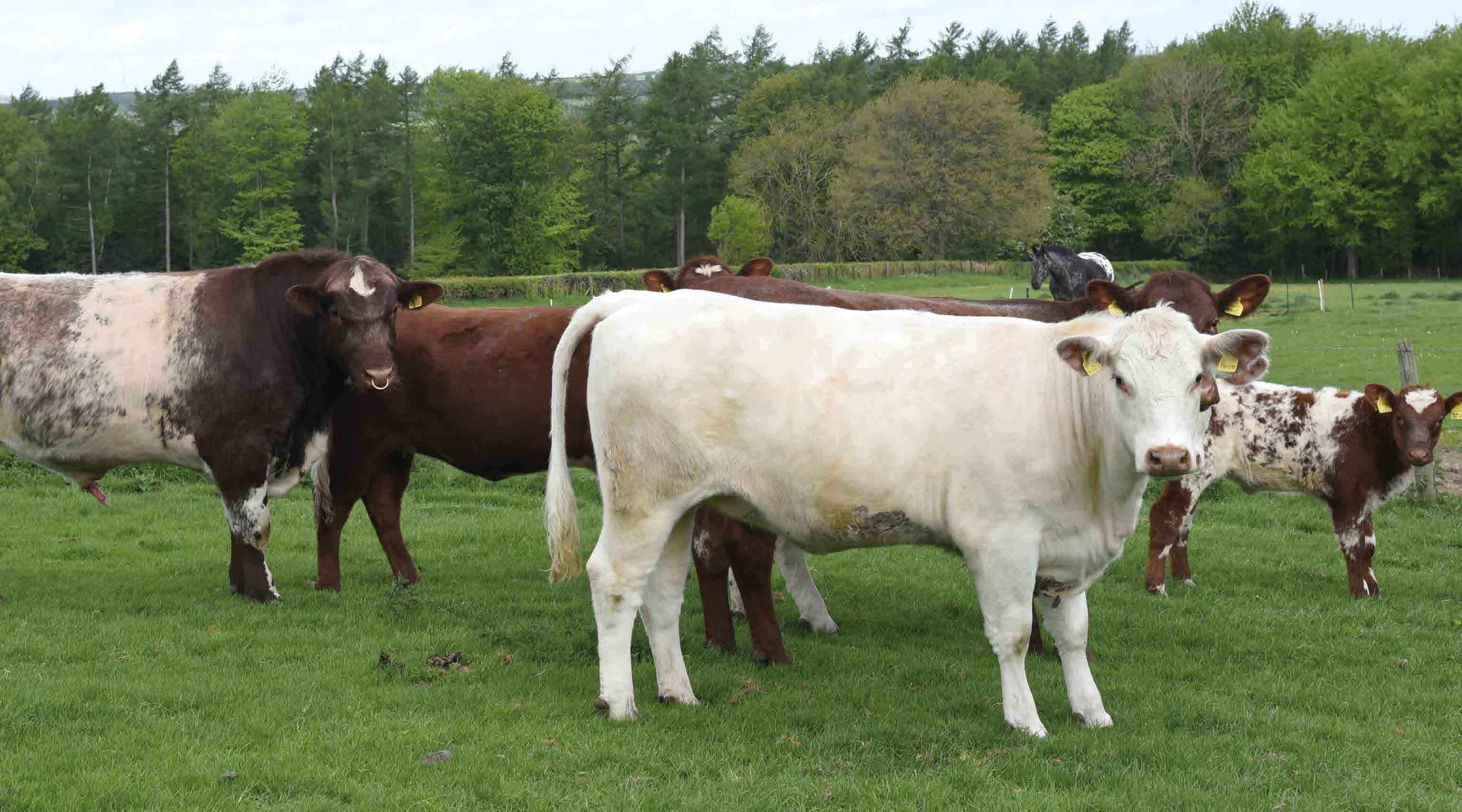
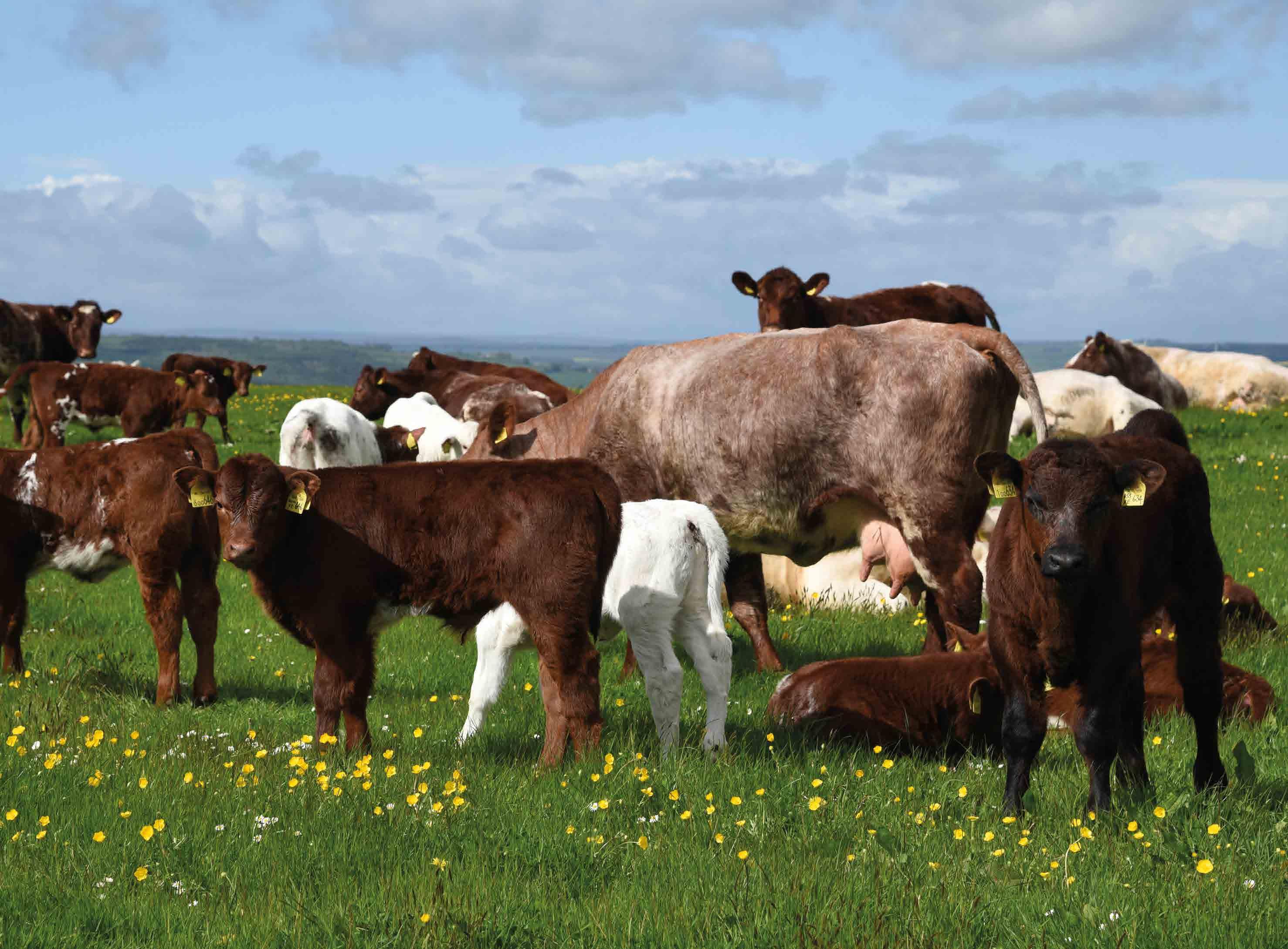
annual visitors at Gibside Estate, a glamping diversification including glamping pods, shepherd's huts and Mongolian yurts was established. Mr Gibson says the diversification works well with the farm, complimenting each other nicely. The farm also sells Shorthorn beef direct to glamping site visitors and via an online shop.
Sustainable cows
Since establishing the Cutthorn herd, it is the diversity of Beef Shorthorns which remains a passion of Mr Gibson’s, as he believes the breed can provide a cow suitable for most farming systems. Once on the rare breeds survival list, Beef Shorthorns are now a commercially viable option for Cutthorn Farm and Mr Gibson believes this docile, maternal breed is the future for many grass-fed farming systems.
‘Scope, capacity, and correctness’ are what Mr Gibson values in his cows. He adds: “It is not all about tall cows, it is about strength and length.” Mr Gibson aims to calve his heifers at 24 months of age, using either one of the farms two stock bulls or artificial insemination (AI). With two
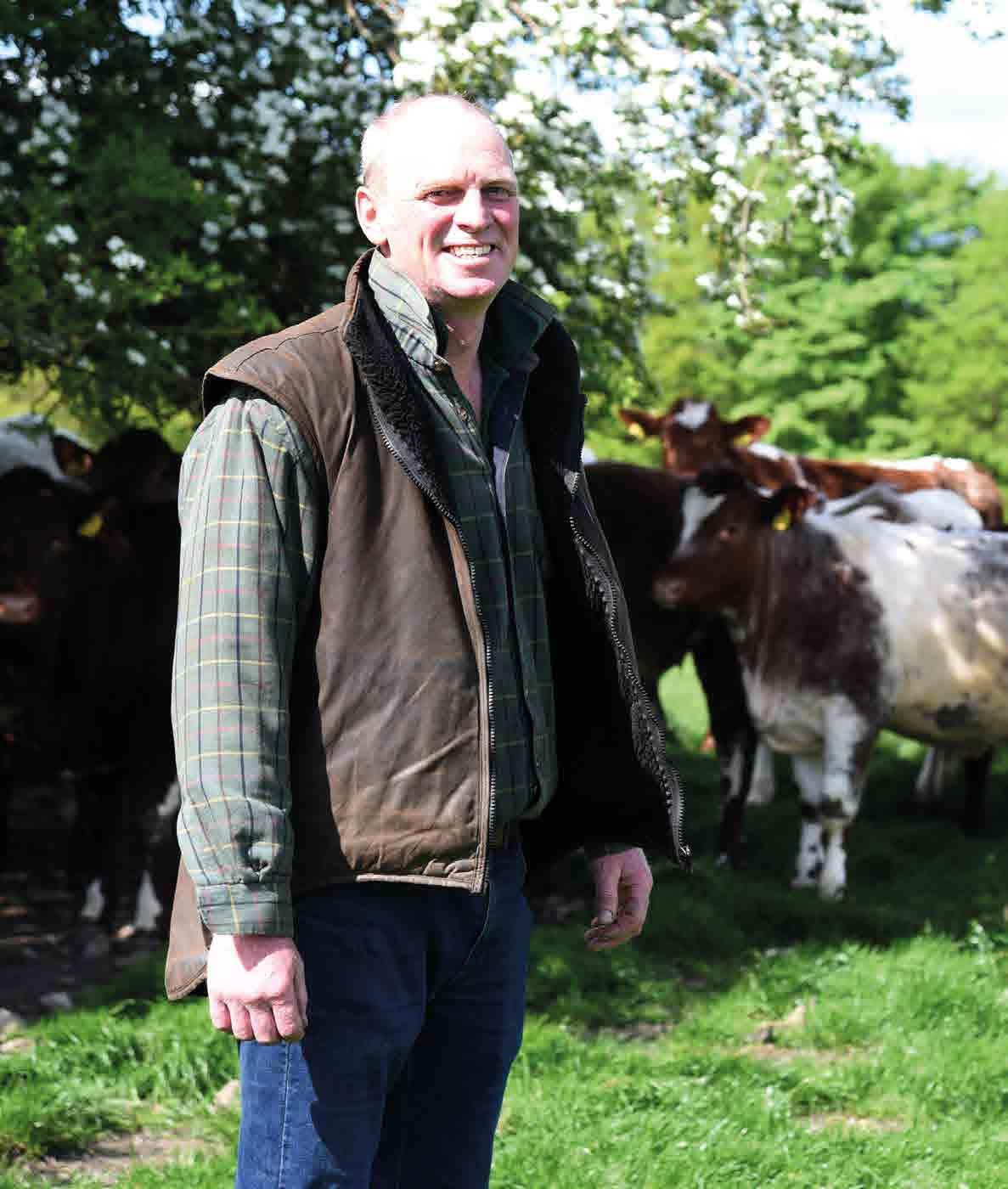
Scope, capacity and correctness are key criteria for Alastair Gibson in the Cutthorn herd.
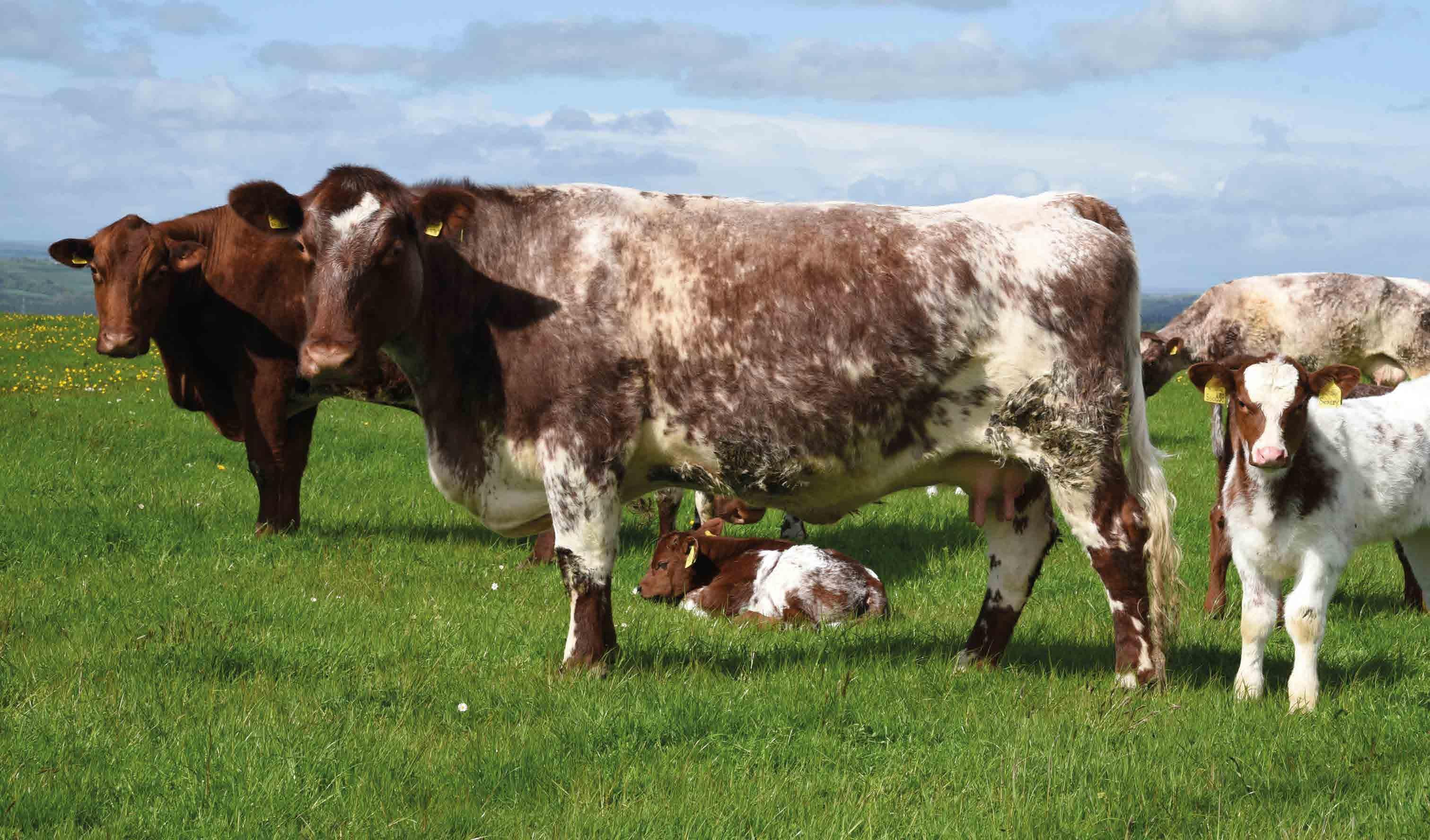
calving cycles, the cows are calved between March and April and July and August, and most calves are weaned at eight months of age.
Generally, if cows are not getting in calf, they will be culled, says Mr Gibson. He adds: “Everything we do on the farm is commercially driven. I will not keep passenger cows for pedigree, they need to be earning their keep.”
Quality surplus heifers are sold annually for breeding, either via Society sales, including Carlisle and Skipton auction marts, or privately on farm. Bullocks are sold as stores through Darlington or Acklington auction marts, with the pick of the bull calves aimed at Society sales such as Stirling and Carlisle. Mr Gibson says private sales are increasing in demand and he is selling more bulls privately on farm with many of his buyers being repeat purchasers.
Currently the Beef Shorthorn Society only allows bulls with one copy of the myostatin gene to be registered, however, Mr Gibson has made the decision to breed his cattle myostatin free. He believes the Society’s decision not to register bulls with more than one copy of the gene is the right thing to do. “People come to the Shorthorn breed to get away from the issues associated with double muscling. I am not against it being in the breed, but I am managing well without it.”
Looking to the future, Mr Gibson believes the breed is going to become even more justified in light of the new Environmental Land Management scheme. “Going forward, if you want to keep cattle you will have to find something sustainable and relevant.” Mr Gibson believes from a financial and commercial perspective it could be massive year for the Beef Shorthorns.
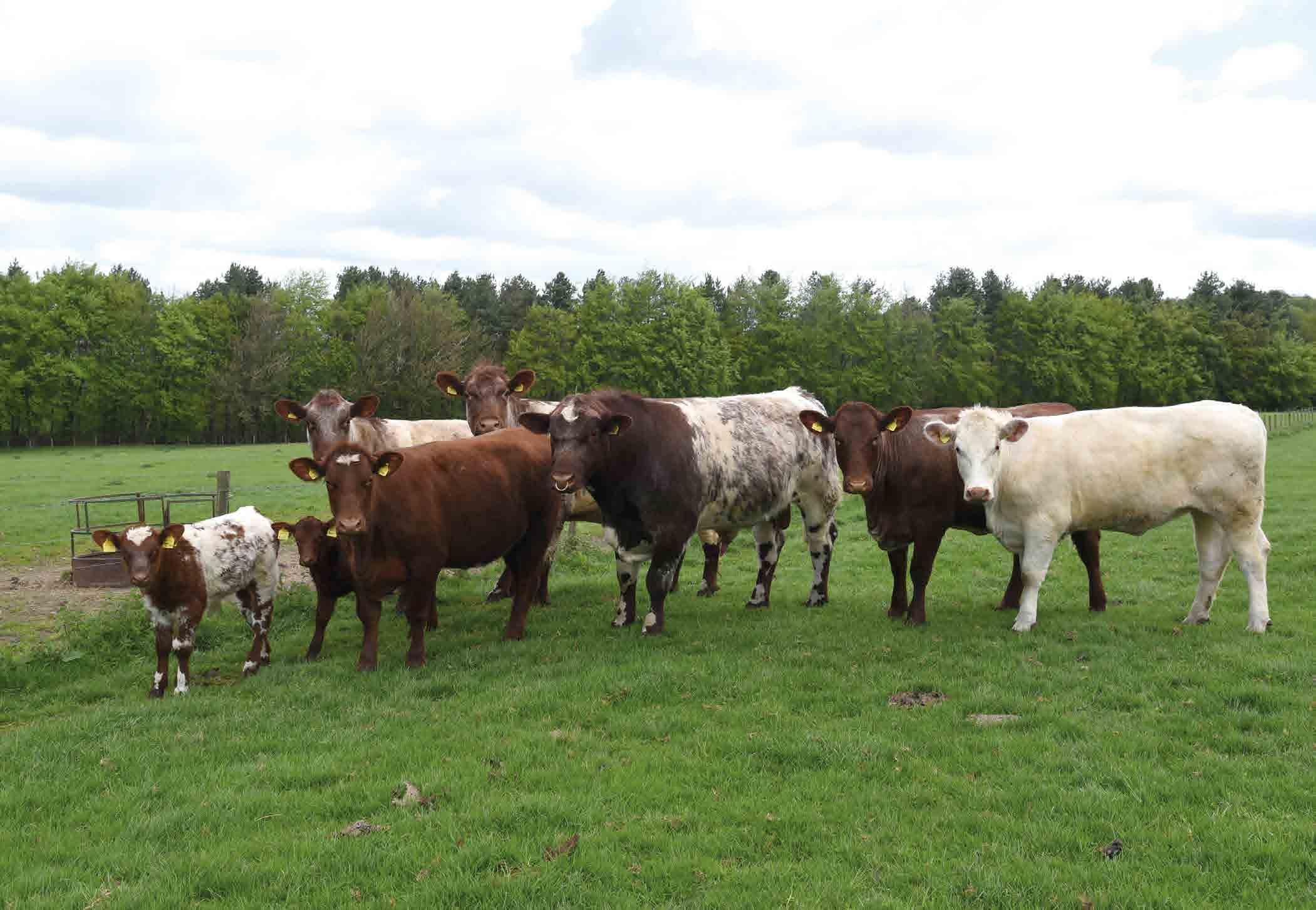
Caramba Oi Edna

All Ireland Sr Female Champion 2022
Westmoor Merlin











